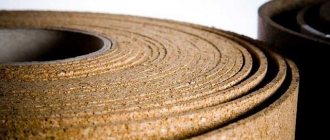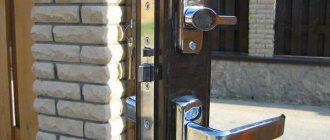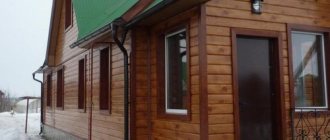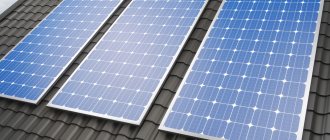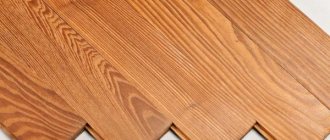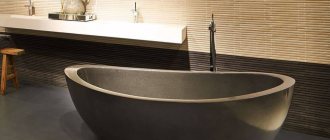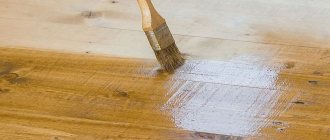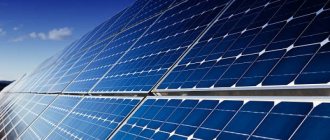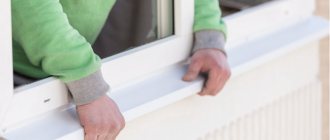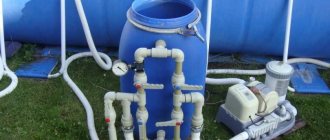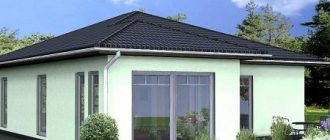Review
Today, thin-film solar batteries, in addition to the classic installation on roofs, can be used instead of glazing. Such modules are distinguished by a variety of colors, which allows buildings to give a unique appearance.
Energy generated by thin-film batteries can be used for domestic needs.
The tempered glass covering the photocells has greater mechanical strength than regular glass and is safer. Therefore, the upper floors of houses in many countries, as well as loggias and balconies, are glazed with it.
In addition, it provides fairly good transparency, guaranteeing high efficiency even in diffuse light, i.e. They not only look aesthetically pleasing, but also save money.
For an opaque battery you will have to pay about 9 thousand rubles, for a partially transparent colored battery (20%) - 16 thousand.
But these days, thin-film solar cells are not as widespread as their crystalline brothers. The reasons lie in their large dimensions and low efficiency.
Nevertheless, experts believe that the future of solar energy lies with them.
They cite the following advantages of thin-film batteries:
- low cost;
- slight difference in efficiency;
- constant increase in the cost of crystalline analogues.
In addition, thin film technology is considered the most reliable. Already today, several types of thin-film batteries, also called “flexible”, have been developed, for the creation of which they use:
- amorphous silicon;
- cadmium telluride/sulfide;
- copper-indium and copper-helium diselenide.
Installation instructions for flexible solar panels
The first step is large-scale planning, which includes designing the system based on the calculation of the required power.
Calculation of the number of panels
The design is based on the following data:
- daily intensity of energy use;
- capacity of the batteries involved;
- overall rated performance of photocells;
- number of modules.
The easiest way to determine electricity consumption is to simply calculate the demands of all electrical appliances in use; the necessary data is indicated on their labeling. In accordance with the obtained value, an inverter is purchased - a device that produces alternating current from direct current with a given frequency parameter. The device is selected with a margin of at least 0.5 kW.
The next step is to calculate the batteries based on the total power of the consumers, taking into account 40% of their minimum charge. The number of solar panels is determined based on the region and priority equipment models.
Features of accommodation
When designing, it should be remembered that solar systems function less efficiently when heating the working components. In particular, in the summer, when the panels are hot, they produce less energy than in the winter - during the cold months, on sunny days, photovoltaic cells capture more light for further processing.
Placing Flexible Solar Panels
Taking into account that the position of the sun changes during the day, the modules are mounted universally - on the south side, tilted no more than 40 degrees.
Installation sequence
Flexible solar panels in rolls are available for DIY installation. Depending on the climatic characteristics of the region, they are placed on top of the roofing pie, on separate auxiliary structures, on the facade of the facility, and the solutions can be combined.
Most often, the solar system is installed on the roof. In cases where the configuration and dimensions of the roof do not facilitate reliable placement of the modules, an auxiliary frame is erected and panels are attached to it. Such projects increase in cost, but they are optimal if the roof is difficult to access or has a complex topography. The facade as a location for modules is rational in cases where the roof has insufficient area. The modules become an element of the design scheme and act as an additional decoration of the object.
Photovoltaic cells are covered on the reverse side with a layer of a sticky substance of resinous origin. For installation, it is necessary to remove the protective film from the panel so that it can be glued to the selected area. The site is first thoroughly cleaned and washed. During the installation process of products, no specialized elements are needed; the only mandatory requirement is compliance with safety measures. You should adhere to the component connection diagram suggested by the manufacturer so that their sequence is maintained.
The solar module is equipped at one end with a pair of lead-out wires, so each product must be placed in such a way that it is easier to connect these cables in the future with one bus, thereby ensuring a serial connection.
Main advantages
This type of thin-film solar panels has many differences from their crystalline counterparts:
- small thickness not exceeding 1 micron;
- excellent flexibility, allowing the panel to be mounted on all kinds of curved surfaces, including cylindrical ones;
- preservation of parameters in diffused light, which will increase the total power generation, in comparison with poly- and monocrystalline panels, by 10, and in some cases by 15 percent;
- low cost of the production process, therefore, low cost of the finished product;
- highly efficient operation in power systems with a power of more than 10 kW and in high temperature conditions;
- significant indicators of optical absorption of the solar spectrum, exceeding the crystalline spectrum by more than 20 times;
- stability of output power for a long time - reliability;
- environmentally friendly, since they have a low proportion of silicon used - 1/000 of that used in crystalline analogues;
- short payback period due to high energy output;
- light weight for easy installation;
- impact resistance. During installation, falls are common, but the film remains operational.
What is special about flexible panels?
When examining a wall decorated with flexible panels, it will be difficult to distinguish a decorative coating consisting of rigid elements. Meanwhile, such products have a number of distinctive features, which include:
- increased flexibility;
- wear resistance;
- soundproofing properties;
- ease of cleaning;
- water resistance;
- a wide range, including panels that imitate natural materials;
- durability;
- ease of installation.
Considering this feature, when choosing a suitable finishing material, most people opt for this option. However, in this case it is necessary to take into account that flexible panels have a small thickness, which places increased demands on the quality of base preparation. In addition, the cost of one element cannot be called low and the material is artificial. This does not allow creating an optimal microclimate.
Device
Triplexes made of tempered glass, in which thin-film solar panels are placed, are reliable protection for the latter. The photographic film is placed under high-strength glass, which is highly transparent and at the same time transparent. The same solution is used in the automotive industry, the production of LED triplexes, and architecture, where it has proven itself to be the best.
We recommend:
- Solar panels work at night and in cloudy weather
- Monocrystalline solar panels: comparison with analogues, advantages, price - TOP-6
- Goal Zero Nomad 14 Plus: solar panel review, appearance, device, advantages and price
Comments:
Megavolt
I read that they released solar batteries in the shape of a round cone, they produce 20% more than conventional batteries. Does anyone know about this technology?
Electrician
Megavolt, let's calculate))) The efficiency of film batteries (namely, they are rolled into a cone) = 10%. We add 20% of 10% to them and get as much as 12% with an increase in cost of at least three times! Breakthrough in savings!
Semyon
Electrician, I also watched this story. It immediately seemed suspicious to me that the entire scientific breakthrough consisted of giving batteries some kind of shape. As if no one had guessed before that the sun was out of place... As always - conspiracy theories and collusion.
Leave a comment Cancel reply
Related Posts
Is it profitable to buy a set of solar panels for a summer residence?
Selecting a battery for a solar power plant
Windmill for a private home - a toy or a real alternative
Fuel-free generator - a way to make money on illiteracy
About technology
To make a thin-film solar structure, semiconductor compounds are sputtered onto a flexible substrate (usually a polymer).
At first, they used exclusively amorphous silicon for this. But, I was not satisfied with the low efficiency of photocells - about 4-5%.
After the advent of selenide and telluride - innovative materials, it was possible to achieve a higher efficiency rate - up to 12%.
pros
The design of a bedroom with panels is also beneficial because the material has practically no disadvantages, but it has plenty of advantages.
- Combines with almost all modern styles. With their help, the room acquires a unique look, which is difficult to achieve with conventional wallpapering.
- Moisture resistance. Thanks to this quality, the finishing material is easy to wash, which means keeping the room clean will not be difficult.
- Easy to install. They are instantly fixed to the surface with a special adhesive composition if the wall is smooth, or to an installed structure with profile fastenings if the wall has flaws. There are options for fastening with clamps.
- Large range of models. Decorative panels for the bedroom are presented in a variety of colors, which allows you to find the best color option. In addition, they may vary in texture, composition and size.
- Resistant to temperature changes. Panels on the wall in the bedroom will protect surfaces from freezing if there is no heating in the winter.
- Practicality. One of the main advantages of finishing. It is not difficult to hide wiring, cables and other communication parts behind the panels. Finishing slabs will hide defects or imperfections in the walls, such as protruding bumps, cracks, holes, etc.
- Antistatic properties. Not all, but most types of models are coated with a special layer that repels dust and dirt.
- Fire resistant. The high-quality composition of the products will protect against fire and ignition.
- Affordable pricing policy. The choice of soft panels for the bedroom wall or other types is so extensive that you will always be able to find the best option according to your financial capabilities.
Vacuum method
The method involves the use of vacuum chambers or electron guns for deposition of diselends from vapor.
In principle, any approach can be used, for example, ion sputtering, but all methods have their own difficulties, such as the formation of a film both on the substrate and on the inner surface of the chamber. Another difficulty is associated with the supply of indium, which is actively used for the manufacture of flat panel monitors.
For such devices, the efficiency can exceed 20%.
Although panels of this type are actively developing, their demand is small and does not exceed 2%.
Films made using cadmium telluride have gained great popularity. Their efficiency is 16% (versus 18%). Amorphous silicon batteries are very popular. Their efficiency was increased to 10%.
Mounting features
The installation procedure for flexible panels may vary significantly. Manufacturers offer a large number of elements with an adhesive base. Installation in this case is performed in the following sequence:
- the foundation is being prepared. The old coating and all existing dirt are removed from the wall. After this, you must carefully inspect the base to check the flatness of the base and any mechanical damage. The wall is leveled by applying a sufficient layer of plaster. Wait for it to dry completely;
- the wall is primed to provide the necessary level of protection from the harmful influences of the environment and increase adhesion to the adhesive composition;
- preparing the material and tools that will be required when performing finishing work. Marking is carried out, which will be used to control the correct spatial position of the element;
- For parts with grooves installed in the corner, protruding fragments are cut off;
- An adhesive composition is applied to the underside of the prepared panels. if the surface is embossed, glue should be applied only to protruding elements;
- the flexible panel is applied to the base. Its position is controlled along the lines of previously applied markings. The panel is carefully pressed to the base;
- Use a clean rag to remove excess adhesive. To do this, you need to carefully smooth the entire surface of the panel with light pressure, ensuring that it fits snugly to the base;
- The remaining panels are glued in the same way. In this case, it is very important to ensure the correct spatial position not only relative to the horizontal or vertical, but also relative to other elements.
If you still have questions regarding the procedure for performing installation work. We suggest watching the following videos to understand the process technology in detail:
In addition to the glue method, there is a frame method. In this case, work is performed in the following sequence:
- The sheathing elements are treated with special antifungal and water-repellent agents. The planks are cut to size and attached to the wall. The screws are screwed strictly vertically to the surface of the plank;
- panels are cut to size using a knife or any other tool with the obligatory formation of an even cut line. The elements are attached to the prepared sheathing with metal staples or a construction stapler;
- We connect the panels to each other using a special lock. We fix it using the chosen method;
- We cut the last panel to size before installation.
Suspension method
In the production of thin-film solar cells, leading specialists use several methods for applying diselenides. The most common is the use of suspended metal oxides.
By changing the concentration and viscosity of the suspension, so-called “ink” is obtained, which is adjusted for a specific technology (from screen printing to jet deposition).
Various materials can also serve as a substrate - metallized foil, glass, even plastic. The efficiency of using the material is very high - 90%, and production is many times cheaper than vacuuming.
The advantage of the method is a uniform and homogeneous spray layer, but the disadvantage is low, compared to vacuum, efficiency - 16% (versus 18%).
What characteristics should you pay attention to when choosing?
When choosing suitable flexible panels for decorating walls in your home, it is worth considering a number of parameters. The required properties will depend on the conditions of subsequent operation. Important parameters may include:
- size and shape. The speed of installation work and the possibility of implementing a specific design project depend on these characteristics. In one case, the desired effect can be achieved by attaching sheet material; in the second case, the best option would be a flexible laminate;
- moisture resistance. This property depends on the quality of the top layer. If you plan to cladding walls in rooms with high levels of humidity, this characteristic is important;
- color and pattern, which are selected taking into account the developed design project.
MDF
MDF panels are made from compressed wood chips, which are specially treated with antiseptic substances.
The material is quite affordable, meets environmental standards and meets the technical requirements of finishing. It is often used as a basis for further painting or painting.
